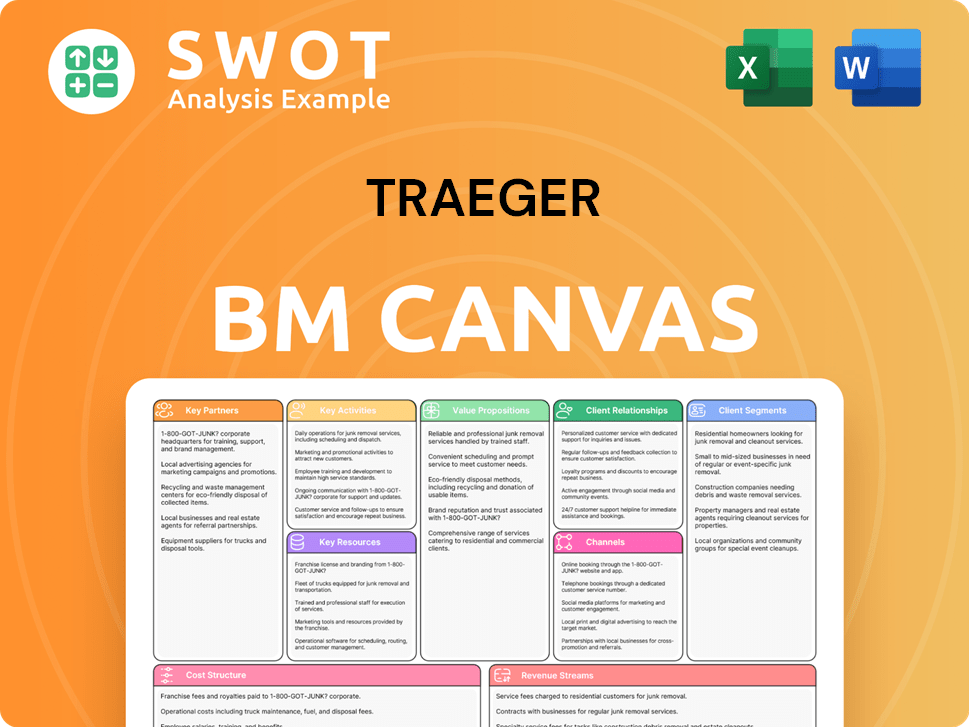Traeger Bundle
How Did Traeger Company Revolutionize Grilling?
Ever wondered about the Traeger SWOT Analysis of the company that redefined outdoor cooking? From its humble beginnings in 1985, Traeger Grills has transformed the grilling experience. This is the story of how a simple invention became a culinary phenomenon.

The Traeger History is a compelling narrative of innovation and market leadership. Discover how Joe Traeger's vision for Wood Pellet Grills has shaped the BBQ Grills industry. Explore the key milestones and innovations that have propelled Traeger Grills to the forefront of the grilling world, and learn how they changed grilling forever.
What is the Traeger Founding Story?
The story of the Traeger Company, a leading name in the grilling industry, began in the early 1980s. This Traeger History is a tale of innovation and a quest for a better grilling experience. The founder, Joe Traeger, a mechanical engineer, sought a solution to the common grilling problems of the time.
Joe Traeger's frustration with traditional grills led him to an innovative idea. He envisioned a grill that could offer the smoky flavor of wood without the hassle of charcoal. This vision would transform the grilling landscape, leading to the creation of Traeger Grills.
The genesis of Traeger Grills can be traced back to Joe Traeger, an inventor and mechanical engineer from Mt. Angel, Oregon, in the early 1980s. Frustrated by the shortcomings of existing outdoor cooking methods—gas grills lacked smoky flavor, and charcoal grills were cumbersome—Joe sought a better solution. Inspired by wood pellet heating systems, he conceived the idea of using compressed wood pellets as fuel for grilling.
Joe Traeger's innovative spirit led to the creation of the first wood pellet grill. This invention revolutionized grilling, offering convenience and flavor.
- The pivotal moment arrived on the Fourth of July in 1985, when a flare-up with his gas grill spurred Joe to create a safer and more flavorful alternative.
- He built the first prototype of the Traeger grill that same year, using a motorized auger to feed wood pellets into a fire pot, generating heat and smoke.
- Traeger Pellet Grills was officially founded in 1987, and the company sold its first commercial wood pellet grill in 1988.
- Joe Traeger secured a patent for his wood pellet grill in 1987, granting Traeger exclusive rights to the technology for 20 years.
The first prototype, built in 1985, used a motorized auger to feed wood pellets into a fire pot. This design provided consistent temperature control and automated operation, a significant advancement over charcoal grilling. Traeger Grills was officially established in 1987, and the first commercial wood pellet grill was sold in 1988. Joe Traeger's patent, secured in 1987, gave the company exclusive rights for two decades. This patent was crucial in establishing Traeger as the sole manufacturer of pellet grills during this period, allowing the family to build a small business. The initial business model involved manufacturing and selling these barbecues from a former dairy farm at the Mt. Angel Abbey.
The company's early years were a family affair, with Joe and his nine children contributing to its growth. Initial funding likely came from bootstrapping and family resources, characteristic of a small, family-owned business in its early stages. The innovation of Traeger Grills changed the grilling experience, offering a new level of convenience and flavor. For a deeper understanding of the competitive landscape, consider exploring the Competitors Landscape of Traeger.
Traeger SWOT Analysis
- Complete SWOT Breakdown
- Fully Customizable
- Editable in Excel & Word
- Professional Formatting
- Investor-Ready Format

What Drove the Early Growth of Traeger?
The early growth of the Traeger Company was significantly shaped by its pioneering wood pellet technology, which gave it a unique advantage in the outdoor cooking market. The company's innovative BBQ grills, known for their consistent temperature control and smoky flavor, quickly gained popularity among grilling enthusiasts. A key early milestone was its feature on 'This Old House' in the early 1990s, which boosted the brand's national presence and accelerated its expansion. By the mid-1990s, Traeger had become a recognized name in the industry.
In the 2000s, Traeger Grills broadened its product line, introducing larger grills and customizable models to cater to diverse grilling preferences. A significant technological advancement came in 2006 with the launch of their 'Digital Controller,' enhancing precise temperature control for users. This expansion helped solidify its position in the wood pellet grills market.
A pivotal transition occurred in 2006 when Joe Traeger and his sons sold the company for $12.4 million. This was followed by the expiration of their foundational patent in 2007, which changed the competitive landscape. In 2014, Jeremy Andrus acquired a minority stake with Trilantic Capital Partners, eventually taking full ownership and becoming CEO, leading to a resurgence.
Manufacturing operations shifted from Oregon to China in 2010. Under Andrus's leadership, the company relocated its headquarters to Salt Lake City, Utah, by September 2015, with all Oregon operations ceasing in 2016. These changes were part of a broader strategy to streamline operations and enhance market reach.
By the end of 2016, Traeger experienced a resurgence, driven by enhanced marketing and strategic initiatives. This renewed interest in wood pellet grills helped the company maintain its market position. The company's ability to adapt and innovate has been key to its longevity and continued success in the competitive grilling market.
Traeger PESTLE Analysis
- Covers All 6 PESTLE Categories
- No Research Needed – Save Hours of Work
- Built by Experts, Trusted by Consultants
- Instant Download, Ready to Use
- 100% Editable, Fully Customizable

What are the key Milestones in Traeger history?
The Traeger Company has a rich Traeger History, marked by significant milestones that have shaped its journey in the grilling industry. From its origins to its current market position, the company's evolution reflects its commitment to innovation and adaptation within the competitive landscape of BBQ Grills and Wood Pellet Grills.
| Year | Milestone |
|---|---|
| 1985 | The invention and patenting of the wood pellet grill, creating a new category in outdoor cooking and marking the beginning of Traeger Grills. |
| 1987 | Official patenting of the wood pellet grill, solidifying its place in the market as the original. |
| 2006 | Introduction of the Digital Controller, enhancing the user experience by providing more precise temperature control. |
| 2007 | Expiration of Joe Traeger's patent, opening the door for competitors in the Wood Pellet Grills market. |
| 2014 | Acquisition by Jeremy Andrus and Trilantic Capital Partners, injecting new life into the brand and leading to significant investments in product development. |
| 2014 | Launch of the Timberline Grill with Wi-Fi connectivity and a meat probe thermometer, showcasing continuous innovation in Traeger Grills. |
| 2023 | Expansion into the griddle category with the Flatrock series, broadening its product offerings. |
| 2025 | Celebration of 40 years of innovation with the introduction of the Woodridge series and the Flatrock 2 Zone Griddle. |
Traeger Grills has consistently pushed the boundaries of grilling technology. These innovations have not only improved the grilling experience but also expanded the company's product offerings, solidifying its position in the market.
The invention and patenting of the wood pellet grill was a groundbreaking innovation. This created a new category in outdoor cooking and set Traeger Grills apart.
The introduction of the Digital Controller in 2006 allowed for more precise temperature control. This enhanced the user experience by providing greater control over the cooking process.
The Timberline Grill, launched in 2014, featured Wi-Fi connectivity. This allowed users to monitor and control their grill remotely, adding convenience.
The Timberline Grill also included a meat probe thermometer. This feature allowed for precise monitoring of internal food temperatures.
The expansion into the griddle category with the Flatrock series in 2023 broadened the company's product offerings. This move diversified the company's product range.
The introduction of the Woodridge series in 2025, along with the Flatrock 2 Zone Griddle, celebrated 40 years of innovation. These new models showcased the company's continued commitment to innovation.
Despite its successes, Traeger Grills has faced several challenges. These experiences have reinforced the company's commitment to innovation and adaptability in a competitive market.
The expiration of Joe Traeger's patent in 2007 opened the door for competitors. This increased competition in the Wood Pellet Grills market.
A 2019 lawsuit alleged that the company's wood pellets did not contain the type of wood advertised. This led to a $1.5 million settlement in 2024, with half going to consumers in coupons.
The company has navigated a dynamic macroeconomic environment. This includes rising interest rates, inflation, and potential trade tariffs.
In Q1 2025, while grill revenues increased by 12.8%, overall revenues decreased by 1.1%. This was due to challenges in the accessories segment, particularly with MEATER smart thermometers.
The company announced a restructuring plan in May 2025 to streamline its organizational structure. This included workforce reductions to enhance profitability and cash flow.
Traeger Grills implemented strategic actions to stabilize MEATER sales. They also focused on supply chain optimizations, cost reductions, and strategic pricing adjustments.
Traeger Business Model Canvas
- Complete 9-Block Business Model Canvas
- Effortlessly Communicate Your Business Strategy
- Investor-Ready BMC Format
- 100% Editable and Customizable
- Clear and Structured Layout

What is the Timeline of Key Events for Traeger?
The Traeger Company, a pioneer in the wood pellet grill market, has a history marked by innovation, strategic shifts, and market adaptation. From its humble beginnings in 1985 with Joe Traeger's invention of the wood pellet grill to its current position, the company's journey reflects the evolution of outdoor cooking and grilling technologies.
| Year | Key Event |
|---|---|
| 1985 | Joe Traeger invents the first wood pellet grill in Mt. Angel, Oregon, marking the beginning of the Traeger Grills story. |
| 1987 | Traeger Pellet Grills is founded and receives a patent for the wood pellet grill, solidifying its innovative position. |
| 1988 | The company sells its first commercial wood pellet grill, starting its journey in the BBQ Grills market. |
| Early 1990s | Traeger gains national exposure through a feature on 'This Old House,' increasing brand awareness. |
| 2006 | Joe Traeger and his sons sell the company to a private equity firm for $12.4 million. |
| 2007 | The foundational patent for the wood pellet grill expires, opening the market to competitors. |
| 2010 | Manufacturing operations are outsourced to China. |
| 2014 | Jeremy Andrus and private equity firm Trilantic Capital Partners acquire Traeger; headquarters relocate to Salt Lake City, Utah. |
| 2016 | All Oregon operations cease. |
| 2019 | A class-action lawsuit is filed regarding wood pellet composition, leading to a settlement in 2024. |
| 2023 | Traeger enters the griddle category with the Flatrock series. |
| January 2025 | Traeger introduces the Woodridge series of wood pellet grills. |
| April 2025 | Traeger launches the Flatrock 2 Zone Griddle. |
| May 2025 | Traeger announces a restructuring plan to streamline its organizational structure. |
For fiscal year 2025, Traeger anticipates total revenues between $595 million and $615 million. Grill revenues are expected to see low single-digit growth, reflecting the company's focus on expanding its market share.
Traeger is implementing several strategic initiatives to mitigate challenges. These include adjusting the supply chain to diversify production outside of China, strategic pricing increases, and cost reduction efforts to improve profitability. A meaningful reduction in reliance on China is expected by 2026.
Product innovation remains a core focus, with continued investment in its product development engine. The successful launch of the Woodridge series and the expansion of the Flatrock griddle lineup demonstrate the company's commitment to innovation in the grilling market.
The company aims to increase brand awareness and market share, leveraging its six-in-one grilling systems and lifestyle-focused branding. Traeger is also exploring opportunities for international market expansion, as well as product diversification to include more accessories.
Traeger Porter's Five Forces Analysis
- Covers All 5 Competitive Forces in Detail
- Structured for Consultants, Students, and Founders
- 100% Editable in Microsoft Word & Excel
- Instant Digital Download – Use Immediately
- Compatible with Mac & PC – Fully Unlocked

Related Blogs
- What is Competitive Landscape of Traeger Company?
- What is Growth Strategy and Future Prospects of Traeger Company?
- How Does Traeger Company Work?
- What is Sales and Marketing Strategy of Traeger Company?
- What is Brief History of Traeger Company?
- Who Owns Traeger Company?
- What is Customer Demographics and Target Market of Traeger Company?
Disclaimer
All information, articles, and product details provided on this website are for general informational and educational purposes only. We do not claim any ownership over, nor do we intend to infringe upon, any trademarks, copyrights, logos, brand names, or other intellectual property mentioned or depicted on this site. Such intellectual property remains the property of its respective owners, and any references here are made solely for identification or informational purposes, without implying any affiliation, endorsement, or partnership.
We make no representations or warranties, express or implied, regarding the accuracy, completeness, or suitability of any content or products presented. Nothing on this website should be construed as legal, tax, investment, financial, medical, or other professional advice. In addition, no part of this site—including articles or product references—constitutes a solicitation, recommendation, endorsement, advertisement, or offer to buy or sell any securities, franchises, or other financial instruments, particularly in jurisdictions where such activity would be unlawful.
All content is of a general nature and may not address the specific circumstances of any individual or entity. It is not a substitute for professional advice or services. Any actions you take based on the information provided here are strictly at your own risk. You accept full responsibility for any decisions or outcomes arising from your use of this website and agree to release us from any liability in connection with your use of, or reliance upon, the content or products found herein.